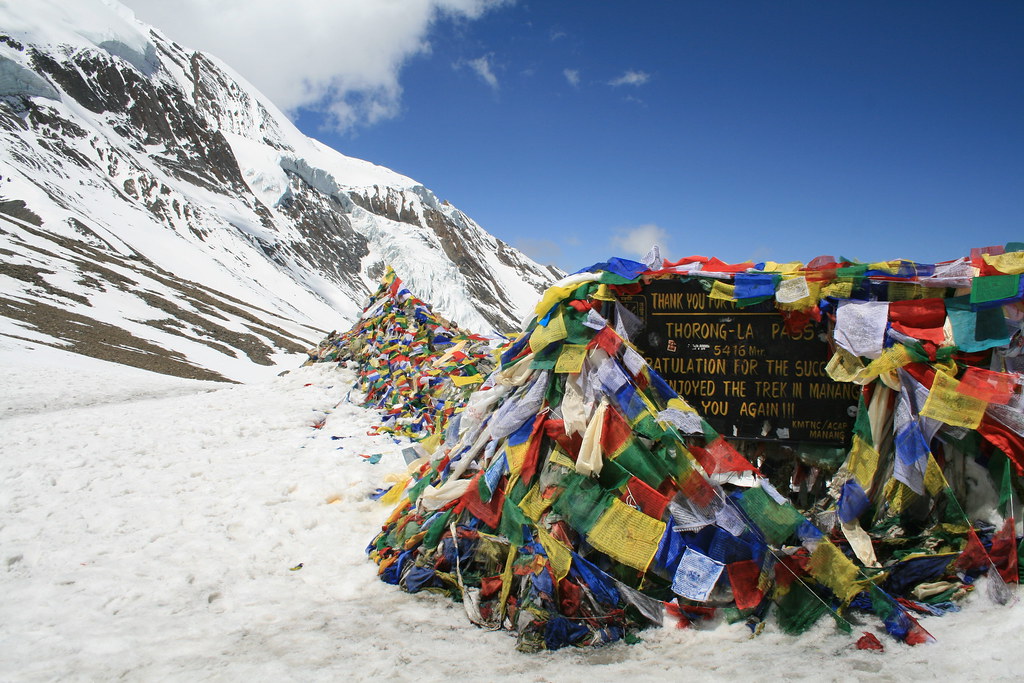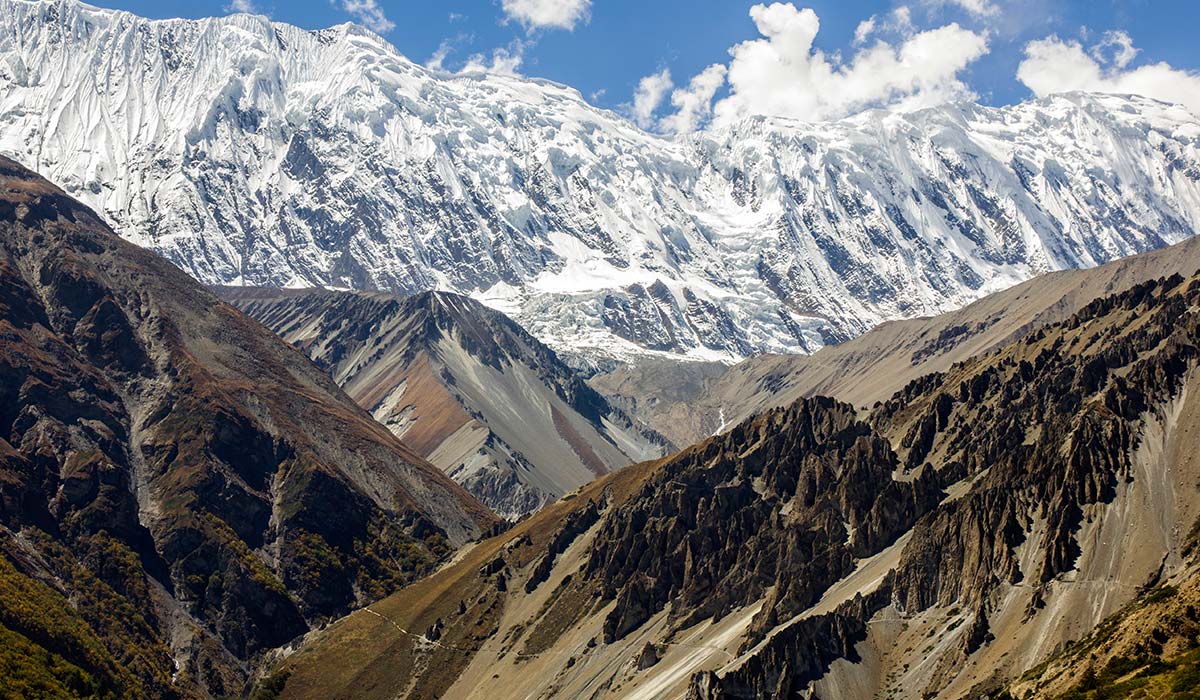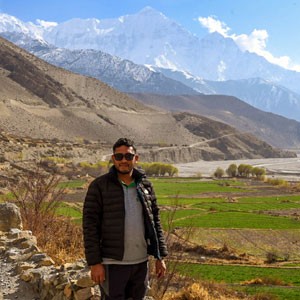Trail Difficulty and Fitness in Manaslu and Annapurna
Both trips are not “easy walks.” You will gain a lot of altitude (4,500m-5,400m) over two weeks or more. On the Annapurna side, you will hit Thorong La Pass at 5,416m. It is a long day, but the villages of Manang and Thorong Phedi give you regular places to rest, eat, and stay warm.

In contrast, Manaslu’s high point, Larky La Pass at 5,160m comes after one steep push from Samdo (3,860 m) through rocky terrain. That section can feel harder because there are fewer lodges and fewer people, so you carry more essentials and rely heavily on your guide or porter. In both treks, you’ll walk 5-8 hours daily on uneven trails, so some basic cardio and hill training before you go will pay off.
Scenery and Landscape
On the Annapurna Circuit trekking trail, your first day’s wind through green valleys, rice terraces, and forests of rhododendron and pine. By Chame and Pisang, it starts to dry out into a cold desert. On clear mornings, you can see Annapurna I, Dhaulagiri, and Nilgiri peeking over the ridges. Once you cross Thorong La, you drop into the Kali Gandaki Gorge, one of the world’s deepest canyons.
The trek to Manaslu Circuit begins similarly rice terraces, then forest but the Budhi Gandaki Gorge feels more rugged and less visited. After Samagoun, you enter open meadows and moraines, with Manaslu (8,163m) dominating the skyline. Fewer lodges here mean the mountains feel more “all yours,” but the trails can be rockier and sometimes snow covered in shoulder seasons.
Villages and Culture
Annapurna’s trail passes through Magar, Gurung, Thakali, and Tibetan influenced villages. In Manang, many families run lodges and speak some English. You’ll see mani walls (stacks of stones with prayers carved) and can visit Braga Monastery near Pisang. At Muktinath (3,800m), both Hindus and Buddhists come to bathe under sacred spouts.
By contrast, the Manaslu Circuit spends more days in villages that see very few trekkers. In Jagat, Deng, Namrung, and Samagoun, people live simpler lives yak herding, barley tending, and daily puja (prayer) in small monasteries. Fewer souvenir shops, more authentic conversations around a stovetop in a teahouse. You need a guide here, though, because local English is limited and permits are checked more strictly.
Permits and Guides
For Annapurna circuit trek, you need an ACAP (Annapurna Conservation Area Permit, about USD 30) and a TIMS card (USD 20). No guide is mandatory, though hiring one or a porter is common and helpful. On the Manaslu Circuit, you must trek with a licensed guide.
You’ll buy a Restricted Area Permit (RAP; roughly USD 70 for the first week and USD 35 for the second), a Manaslu Conservation Area Permit (USD 25), and a TIMS card (USD 20). Because it’s a “restricted area,” you can’t wander freely without your guide. A guide costs around USD 25-30 per day and also eats and sleeps in the same teahouses as you.
Cost Comparison Between Manaslu Circuit and Annapurna Circuit Trek
Money goes farther on either trek than in Western countries, but costs add up at higher altitudes. On the Annapurna trek, budget around USD 8-10 per day for food and USD 6-8 per night for a basic teahouse room. On the Manaslu trekking, meals run USD10-12 per day higher up, and rooms average USD 9-12 per night once you’re above 3,000m.
If you hire a guide (its mandatory in Manaslu region), it’s USD 30-40 per day. On the Annapurna region, guides charge about USD 30-35 per day. Porters cost roughly USD 20-25 per day on both routes. Add permits (USD 50 total on Annapurna vs. USD 125+ on Manaslu) and transport (buses or jeeps from Kathmandu), and you end up spending about USD 900-1200 on Annapurna with a guide, or USD 1,200+ on Manaslu with a guide and porter. Of course, you can adjust this by taking shorter itineraries or cheaper lodges, but the basic math is that Manaslu is pricier because of mandatory guide fees and fewer budget teahouses.
Accommodation and Food in Manaslu and Annapurna Trek Route
On the Annapurna Circuit trekking route, teahouses are frequent, menus get more varied (momo, pancakes, pizza, dal bhat), and some places even have western style bathrooms and Wi Fi. In Manang and Chame, you can find lodges with fluffy duvets and hot showers (NPR 300-500, about USD 2-4).
On Manaslu trekking route, teahouses are sparser. In villages like Samagoun and Samdo, rooms are basic: a foam pad, a thin blanket, and sometimes a crackling wood stove. Hot water costs extra (around USD 2-3), and you may share a four person room at 4,000 m. Menus stay simple: dal bhat, noodles, soup, and maybe a small “special” like Thakali khana. Electricity is solar powered, so phone charging is about USD 2 per device, and Wi Fi is rare or slow.
Best Time for Manaslu and Annapurna Circuit Trek
Both treks shine in autumn (late September-November) and spring (March-May). In autumn, skies are clear, daytime temperatures in the high camp areas hover around 0–10 °C, and nights dip around 5 °C. On Annapurna, mid October has crowded teahouses but perfect mountain views. Manaslu is less crowded, so in late October you might find yourself almost alone above 4,000 m.
Spring brings blooming rhododendrons, especially beautiful on lower altitude sections of both treks. Monsoon (June-August) brings heavy rain and potential landslides on both routes, though Annapurna’s upper sections stay drier once you pass 3,000 m. Winter (December-February) is doable only for very experienced, well equipped trekkers: Manaslu’s high passes are snowed in, and Annapurna’s Thorong La can be icy and dangerous.

Altitude and Acclimatization
Altitude sickness is a big deal. Annapurna trekking region , most people pause two nights in Manang (3,540 m) so their bodies can adjust before climbing to Thorong Phedi (4,540 m) and then crossing Thorong La (5,416 m). If you feel dizzy or nauseous, rest, don’t push on.
Manaslu trekking region requires rest a day in Samagoun (3,530 m) with possible hikes to Pung Gyen Gompa (4,100 m) before moving up to Larkya Phedi (4,460 m). From there, Larke La (5,160 m) comes early next morning.
Drinking lots of water, eating carbs, and sleeping low when you can all help. If symptoms worsen persistent headache, breathlessness, confusion descend immediately, even if it means cutting the trek short.
Safety and Medical Support
Annapurna Circuit has more infrastructure: Himalayan Rescue Association (HRA) clinics in Chame (2,710 m) and Manang (3,540 m) where doctors check oxygen levels and treat mild altitude sickness. Mobile phone coverage is decent up to Manang, and helicopter evacuations operate regularly from Manang or Jomsom.
Medical facilities Manaslu circuit trail are scant. Samagoun has a small NMA (Nepal Mountaineering Association) clinic where volunteer doctors may be on hand, but equipment is limited. Mobile coverage is spotty, and rescue choppers fly from Samagoun or Dharapani only in clear weather. That’s why having a licensed guide is not just a permit formality, it’s your main line of help if things go wrong. In both treks, carry a basic first aid kit, a blister kit, a pulse oximeter if you can, and ensure your travel insurance covers high altitude evacuation.
Crowds and Atmosphere
Annapurna circuit sees thousands of trekkers each month in peak seasons. Around Manang and Thorong Phedi, you’ll share dining tables with 30–50 other people, and finding a bed can mean lining up early. For many, that’s part of the fun as you can make new friends, share stories, and hear many languages over a cup of tea.
Manaslu circuit, by comparison, stays quiet. In peak weeks, you might pass five or six other groups in a day. Expect long stretches of silence broken only by prayer flags fluttering or water rushing in the Budhi Gandaki River. If you crave solitude or want raw Himalayan vibes, Manaslu has it. If you enjoy a lively trek where teahouses feel alive, Annapurna is your scene.
Highlights and Side Trips
On Annapurna circuit trek, many trekkers add short side trips: Ghorepani-Poon Hill for a sunrise view (3,210 m) or a detour to Tilicho Lake (4,919 m) for a two night out and back. Coming down from Thorong La, Muktinath Temple (3,800 m) is a peaceful spot with 108 water taps and both Hindu and Buddhist pilgrims.
On Manaslu circuit trek, side highlights include Pung Gyen Gompa (a 300 year old monastery at 4,200 m) and Birendra Tal (a glacial lake at 4,290 m, often reflecting Mount Himalchuli). Both are doable with an extra day or two, just make sure your guide knows the plan. On Manaslu, because the trail is less defined, side trips may involve more route finding and a bit of scrambling.
Tips for First-Time Himalaya Trekkers
No matter which circuit you choose, here are general guidelines to make the journey smoother.
Train Several Months Ahead: Focus on long hikes of 4-5 hours with a loaded backpack (10-12 kg). Include both uphill and downhill training as descents can be as painful as climbs.
Pack Smart: A three-season sleeping bag (comfort rated to -5°C) is essential above 3,000 m. Bring thermal base layers, a fleece or down jacket, waterproof shell, gloves, and woolen hat. Down socks for camp nights keep you toasty.
Footwear and Blister Care: Invest in well-broken-in trekking boots with ankle support. Carry blister plasters and friction tape. Always dry your feet fully before putting on socks each morning.
Layer Your Clothing: In high camps, nights can be 10 °C and days around 0-5 °C. On sunny afternoons in mid-elevation, T-shirt and shorts may feel comfortable. Thick in layers base, mid, outer and avoid cotton.
Water Purification: Carry a UV pen (Steripen) or chemical tablets, and buy one bottle of purified water and then refill using your own method to save money and reduce plastic waste.
Sleep Low, Climb High: This age-old advice helps your body adjust. If your lodge is at 3,500 m, hike to 4,000 m in the afternoon, enjoy the view, then return to sleep at 3,500 m.
Respect Local Culture: Ask permission before photographing villagers, especially women. Always remove shoes before entering a teahouse dining hall. Use “Namaste” (palms together at chest) when greeting.
Carry Enough Cash: ATMs exist only in Besisahar, Dharapani, and Manang and they often run out of money. Carry at least NPR 20,000 (USD 160) in Kathmandu before departure for teahouse bills, permits, and tipping.
Research Your Guide/Agency: For Manaslu, you must go through a licensed agency. Ask for references, verify insurance coverage for porters, and confirm whether the guide speaks good English and has rescue training.
Pre-Book Accommodations (October-November): For Annapurna Circuit, if you want a private room in Manang or a spot at Thorong Phedi, try to reserve in September. On Manaslu, ask your agency to inform distant lodges you’re coming.
Hydration: Purify water with a filter or tablets. Buying bottled water at each lodge adds up and creates plastic waste.
Manaslu Circuit or Annapurna Circuit Trek; Which is better?
When you’re choosing between the Annapurna Circuit and the Manaslu Circuit trek, it really comes down to what kind of experience you want. The Annapurna Circuit is famous for its diverse landscapes: you start in lower, lush valleys and work your way up past terraced fields, rhododendron forests, and high mountain deserts before crossing the Thorong La Pass at 5,416 meters.
Along the way, you’ll see the Annapurna Massif, Dhaulagiri, and other peaks. Villages are more frequent, teahouses are well established, and you’ll meet trekkers from all over the world. Because this trail has been popular for decades, there’s plenty of infrastructure i.e. reliable lodges, marked paths, and even internet access in many of the villages. If you like a well-trodden route where you can stop for a warm meal and a cozy room almost every day, Annapurna is a solid choice.

On the other hand, the Manaslu Circuit feels more remote and untouched. This trail circles Mount Manaslu (8,163 meters) and reaches up to the Larky La Pass at 5,160 meters. Compared to Annapurna, you’ll encounter fewer trekkers and more traditional Tibetan-influenced villages. The lodges are more basic sometimes just a simple tea house with a mattress and blanket but that simplicity gives you a real sense of adventure. The landscape changes from green river valleys to the dramatic, barren slopes of the high Himalaya. Wildlife is more abundant, too; you might spot musk deer or even a snow leopard footprint if you’re lucky. It’s quieter, less commercialized, and gives you a stronger feeling of exploring an area that hasn’t been altered by tourism as much.
Difficulty-wise, both treks have high passes to cross and demand a good level of fitness and acclimatization. Annapurna Circuit takes longer usually around 15 to 18 days so you’ll walk more total kilometers, but the daily altitude gains are calmer. Manaslu Circuit is shorter, often done in about 14 days, but the spacing between stops can be longer.
On Annapurna circuit trek, you can plan to stop at places like Manang or Muktinath to rest and acclimatize. On the trekking to Manaslu, you have to carefully watch your acclimatization plan because lodges are sparse and villages less frequent. If you’ve done high-altitude treks before and want a slightly steeper challenge without the crowds, Manaslu might suit you. If you prefer a gradual build-up of altitude alongside comfortable guesthouses, pick Annapurna.
When it comes to permits and regulations, Annapurna is fairly straightforward: you need an Annapurna Conservation Area Permit (ACAP) and a Trekkers’ Information Management System (TIMS) card. The trail is open year-round, though winter can be very cold and monsoon season brings heavy rain. For Manaslu, you must travel in a registered group with a licensed guide, and the permit fees are higher.
The Manaslu Conservation Area Permit covers the hike, and you’ll need to coordinate with a trekking agency. The trek is closed during monsoon (June to August) and can also be closed temporarily for political or environmental reasons. So if you like more independence, Annapurna has a looser setup. If you’re happy to book through an agency and want that extra layer of safety in remoter terrain, that’s a plus for Manaslu.
Culturally, Annapurna Circuit treks is dotted with Gurung, Thakali, and Tibetan-influenced villages where you’ll see ancient monasteries, mani walls, and local markets. You’ll pass through areas that have become accustomed to tourism, so you can find souvenirs, internet cafés, and even small souvenir shops. Many villagers speak some English and cater to trekkers.

In Manaslu trekking route, the culture leans heavily toward Tibetan Buddhist traditions with prayer flags, mani rocks, and Gompas tucked into high cliffs. The local people live in more traditional styles, farming barley and yak, and you might spend a night in a mud-brick house with minimal comforts. There’s less English spoken overall, so trekking with a guide helps you connect with the community. If you want deeper cultural immersion, Manaslu’s quieter villages may appeal more, whereas Annapurna offers a mix of cultural sights with modern conveniences.
In summary, the hike to Annapurna Circuit is best if you want a well-marked trail, steady infrastructure, a wider range of accommodation, and the chance to meet other trekkers along the way. It’s ideal for first-timers tackling a multi-day high-altitude trek. The Manaslu Circuit is best if you’re looking for solitude, rugged scenery, a sense of real exploration, and don’t mind paying a bit more or relying on a guide. Both offer stunning mountain views, friendly villagers, and a deep connection to Himalayan culture, but your choice depends on whether you prefer comfort and community (Annapurna) or remoteness and tradition (Manaslu).
Conclusion
Both the Annapurna circuit trek and Manaslu Circuits deliver unforgettable scenery, warm Nepali hospitality, and a sense of real achievement. Annapurna is more traveled, full of teahouses, side trips, and a buzzing social vibe while Manaslu is quieter, wilder, and deeply steeped in Tibetan culture. Choose based on your comfort level, budget, and appetite for solitude.
Whether the monolithic peak of Manaslu calls to you or the sweeping grandeur of the Annapurna ranges beckons, both circuits offer a lifetime’s worth of memories. Manaslu Circuit is for the trekker who dreams of remoteness, Tibetan culture, and testing themselves on less-traveled paths. Annapurna Circuit hike suits those who value variety, lush forests, cold desert, high passes combined with reliable teahouses and a social trekking scene.
Weigh your priorities, time available budget, desire for solitude, appetite for culture, and choose with confidence. And remember, the ultimate reward isn’t just standing on a pass but the countless moments in between sharing a warm meal with a family in a remote village, gasping at a sunrise that lights up the snows of Annapurna, or laughing with new friends in a tiny teahouse at 3,500m. Pack well, train hard, and may both the trail and the mountains inspire you long after you’ve descended. Safe travels and happy trekking!





